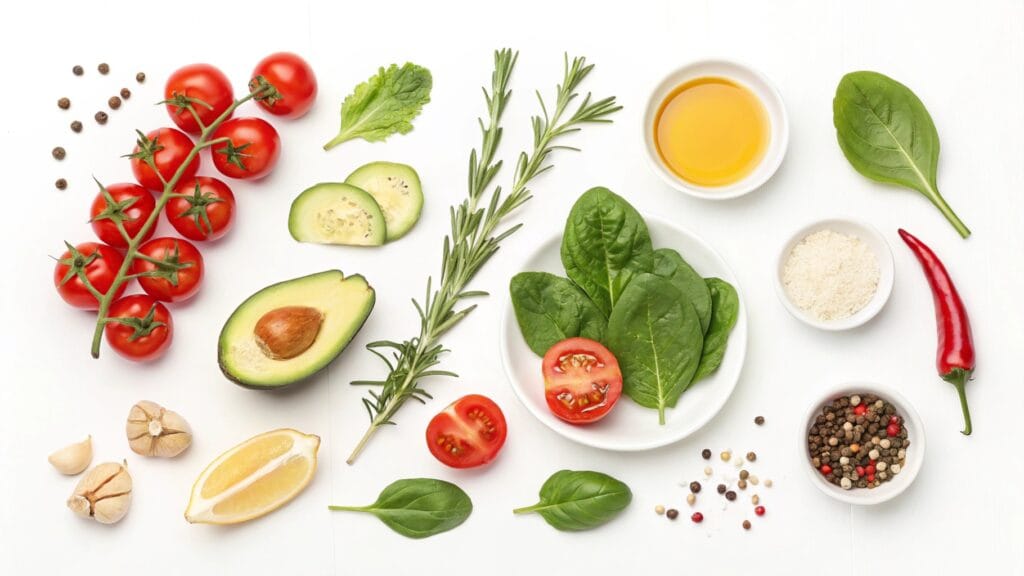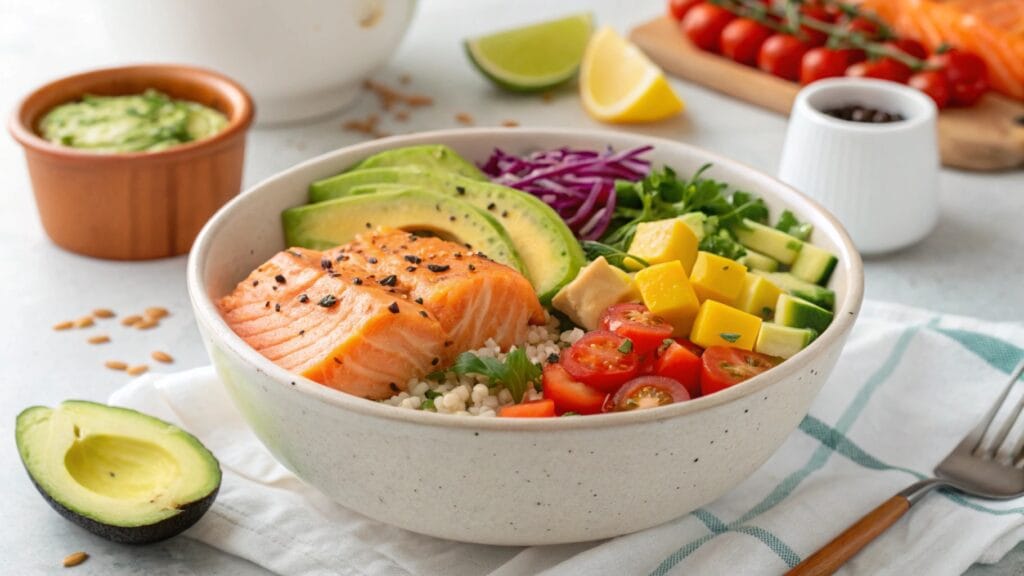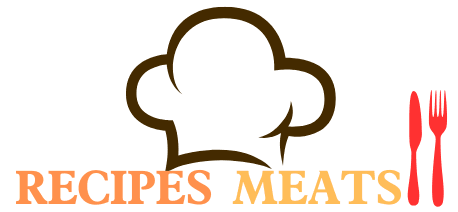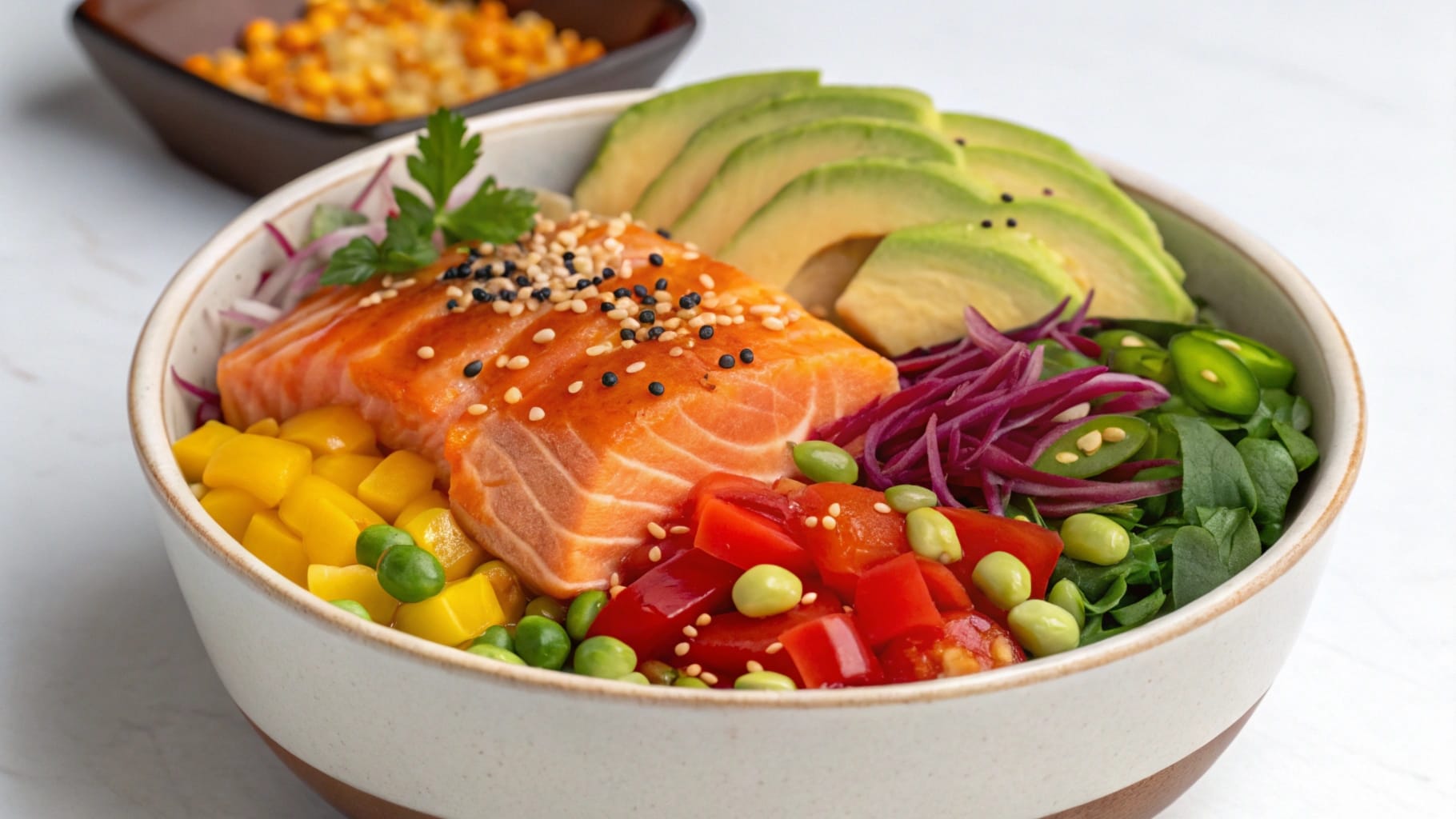Introduction to Salmon Bowls
When it comes to creating a delicious and healthy meal, the right salmon bowl ingredients make all the difference. From fresh, high-quality salmon to vibrant vegetables and flavorful sauces, every component plays a crucial role in building the perfect bowl. Whether you’re a fan of bold flavors or light, refreshing meals, selecting the best salmon bowl ingredients ensures every bite is satisfying and packed with nutrition.
What Makes Salmon Bowls Popular?
Salmon bowls are like the Swiss army knife of meals—they’re versatile, quick, and incredibly satisfying. Think about it: You get protein, carbs, and veggies all in one dish. It’s like having a balanced diet without the hassle. And let’s not forget how Instagram-worthy they are! 📸✨
The Health Benefits of Salmon Bowls
Eating a salmon bowl isn’t just about satisfying your taste buds; it’s also a health jackpot. Salmon is packed with omega-3 fatty acids, which are amazing for your brain and heart. Add some vibrant veggies and whole grains, and you’ve got a meal that’s a nutrition powerhouse. Say goodbye to boring salads and hello to wholesome goodness!

Key Ingredients for a Perfect Salmon Bowl
Fresh Salmon: The Star Ingredient
When it comes to crafting a memorable dish, the choice of salmon bowl ingredients is crucial. Fresh salmon, vibrant vegetables, and flavorful toppings are just the beginning. Every element plays a role in enhancing the overall taste and appeal of your bowl. Let’s dive into the essential salmon bowl ingredients you need to create this culinary delight
Grains and Bases: Rice, Quinoa, or Alternatives
The base of your salmon bowl is like the canvas of a painting. White rice, brown rice, or even quinoa are classic options. Want to go low-carb? Cauliflower rice or zucchini noodles are great choices. Whatever you pick, make sure it complements the salmon’s rich taste.
Here’s a quick comparison to help you decide:
| Base | Calories (per cup) | Key Benefits |
|---|---|---|
| White Rice | 200 | Simple and pairs well with flavors. |
| Brown Rice | 215 | High in fiber and nutrients. |
| Quinoa | 220 | Packed with protein and gluten-free. |
| Cauliflower Rice | 25 | Low-carb and keto-friendly. |
Vibrant Vegetables for Color and Nutrition
Imagine a bowl of salmon without the veggies—it’s like a movie without a soundtrack. Boring, right? Go for a mix of textures and colors. Think crunchy cucumbers, creamy avocado slices, shredded carrots, and crispy bell peppers. Not only do these add a splash of vibrancy, but they also amp up the nutrition.
Flavorful Sauces and Dressings
A good sauce is like the cherry on top, except it’s savory and oh-so-delicious. Popular choices include soy sauce, teriyaki glaze, or creamy sesame dressing. If you’re feeling adventurous, whip up your own sauce with ingredients like tahini, lime juice, and honey. 🍯
“A great sauce doesn’t just enhance the bowl; it tells a story of flavors blending together in harmony.”
Toppings and Garnishes to Elevate the Dish
Toppings are where you can let your creativity shine. Sprinkle some sesame seeds for a nutty crunch, or add a dash of chili flakes if you like a little heat. Microgreens, pickled ginger, or even a poached egg can take your salmon bowl to the next level.
Common Problems When Preparing Salmon Bowls
Choosing the Right Type of Salmon
Struggling with selecting the right salmon bowl ingredients? You’re not alone. Many people find it challenging to balance flavors or keep their ingredients fresh. By choosing high-quality salmon bowl ingredients and storing them correctly, you can avoid these issues and enjoy a perfect meal every time.
Balancing Flavors: Avoiding Blandness or Overpowering Tastes
One common mistake is going overboard with sauces or skimping on seasoning. The result? Either a bland bowl or one that feels like a flavor explosion gone wrong. Finding that sweet spot is key.
Keeping Ingredients Fresh and Crisp
No one likes soggy veggies or wilted greens. Always prep your ingredients fresh and store them properly to retain their crunch and vibrancy.
Overcooked or Undercooked Salmon Issues
Cooking salmon can be tricky. Overcook it, and it turns dry and rubbery. Undercook it, and it might not be safe to eat. Use a meat thermometer to ensure it’s cooked to perfection (145°F or 63°C is the sweet spot).
Solutions and Tips for Perfecting Salmon Bowls
How to Pick the Freshest Salmon
Here’s a little trick: If you’re buying fresh salmon, press your finger gently on the flesh. It should bounce back and not leave an indentation. And if you’re going for frozen, check that it’s vacuum-sealed and free from ice crystals.
Tips for Cooking Salmon Perfectly Every Time
Grilling, baking, or pan-searing—no matter your method, timing is everything. For a quick fix, marinate your salmon for at least 30 minutes to lock in flavor before cooking. And always rest it for a few minutes after cooking to keep it juicy.
Preparing Ingredients in Advance for Convenience
Busy week? No problem. Cook your grains and chop your veggies in advance. Store them separately in airtight containers. When it’s time to assemble, it’s as easy as putting together a puzzle.
Creating Balanced and Unique Flavor Profiles
Think of your salmon bowl as a symphony. Each ingredient should play its part without overpowering the others. A pinch of salt, a squeeze of lemon, or a drizzle of honey can make all the difference.
Popular Variations of Salmon Bowls
Asian-Inspired Salmon Bowls
If you love bold, umami flavors, an Asian-inspired salmon bowl might just be your next obsession. Picture this: tender salmon glazed with teriyaki sauce, sitting on a bed of jasmine rice, and topped with crunchy edamame, shredded carrots, and a drizzle of spicy mayo. Add a sprinkle of sesame seeds and a few slices of pickled ginger, and you’ve got yourself a masterpiece.
Want to make it even better? Toss in some seaweed salad or thinly sliced radishes for extra crunch and authenticity. This variation is perfect for sushi lovers who want the same flavors in a heartier dish. 🍣
Mediterranean-Style Salmon Bowls
Let’s take a trip to the sunny coasts of the Mediterranean! This version swaps rice for fluffy couscous or quinoa and features ingredients like cherry tomatoes, kalamata olives, cucumber slices, and crumbled feta cheese. The dressing? A zesty mix of olive oil, lemon juice, garlic, and oregano.
Mediterranean salmon bowls are light, refreshing, and packed with antioxidants. They’re like summer in a bowl, perfect for those days when you’re craving something fresh and tangy. 🌞
Low-Carb or Keto Salmon Bowls
Cutting down on carbs doesn’t mean you have to compromise on flavor. For a keto-friendly option, ditch the grains and use a bed of mixed greens or cauliflower rice instead. Top it with creamy avocado, crispy bacon bits, and a dollop of ranch dressing or garlic aioli.
The best part? The high-fat content from the avocado and salmon keeps you full and satisfied for hours. Who said healthy eating can’t be delicious? 🥑
Creative Ingredient Ideas for Salmon Bowls
Seasonal Vegetables to Try
Why stick to the usual veggies when there are so many seasonal options to explore? In spring, add some steamed asparagus or sugar snap peas. Summer is perfect for roasted zucchini and cherry tomatoes. In the fall, try caramelized sweet potatoes or roasted Brussels sprouts. Winter calls for earthy root vegetables like carrots and parsnips.
Seasonal ingredients not only taste better but are also more affordable and environmentally friendly. Win-win! 🌱
Unique Grains and Alternative Bases
Tired of rice and quinoa? Switch things up with farro, barley, or even soba noodles. These options add unique textures and flavors to your salmon bowl. For a gluten-free twist, try millet or buckwheat.
Here’s a handy table to guide you:
| Base | Texture | Pairing Tip |
|---|---|---|
| Farro | Chewy and nutty | Great with roasted veggies. |
| Barley | Soft and hearty | Works well with creamy dressings. |
| Soba Noodles | Silky and light | Perfect for Asian flavors. |
| Millet | Fluffy and light | Goes well with tangy dressings. |
Homemade Sauces for a Personal Touch
There’s nothing quite like a homemade sauce to elevate your bowl. It’s like the secret ingredient that makes everyone go, “Wow, what’s in this?” Try these:
- Honey-Sriracha Sauce: Sweet, spicy, and sticky—a crowd favorite.
- Lemon-Dill Yogurt Sauce: Creamy and refreshing, perfect for Mediterranean bowls.
- Peanut Sauce: Nutty and rich, ideal for Asian-inspired creations.
“Homemade sauces let you control the flavor and nutrition, making every bite unforgettable.”
Final Thoughts: Making Your Salmon Bowls Unforgettable
Salmon bowls are more than just a meal—they’re an experience. From choosing the freshest salmon to experimenting with unique ingredients and flavors, there’s endless room for creativity. Whether you’re in the mood for something light and refreshing or bold and indulgent, there’s a salmon bowl for every craving.
So, next time you’re planning your meals, don’t settle for boring. Whip up a salmon bowl that not only nourishes your body but also excites your taste buds. Trust me, it’ll become your new favorite dish in no time. 😋
Nutrition Facts of a Classic Salmon Bowl (Per Serving)
| Nutrient | Amount |
|---|---|
| Calories | 450-550 kcal |
| Protein | 35-40 g |
| Carbohydrates | 40-50 g |
| Fats | 18-22 g |
| Fiber | 5-8 g |
| Omega-3 Fatty Acids | 1.5-2.5 g |
By following this guide, you’re not just making a salmon bowl—you’re crafting a culinary masterpiece. 🍽️ Let me know if you’d like additional tips or ideas! 😊
Common Problems When Preparing Salmon Bowls
Choosing the Right Type of Salmon
This is a big one. Have you ever been disappointed by salmon that tastes too fishy or has a mushy texture? That usually happens when you pick the wrong kind. Here’s a pro tip: always choose wild-caught salmon over farmed salmon when you can. Wild-caught salmon has a richer flavor and more nutrients because it comes from natural habitats.
If fresh salmon isn’t an option, don’t worry—frozen can work too. Just make sure to thaw it properly by placing it in the fridge overnight. Avoid leaving it out on the counter, as that can mess with the texture and taste.
Balancing Flavors: Avoiding Blandness or Overpowering Tastes
A salmon bowl is all about balance. Imagine adding a super salty sauce or not seasoning your salmon at all—it’s not fun. The key is to layer flavors. Start with a basic marinade for the salmon (like soy sauce, garlic, and honey), then pair it with a neutral base like rice or quinoa. The veggies and sauces you add will tie everything together.
Keeping Ingredients Fresh and Crisp
No one likes soggy veggies or limp greens. To keep your bowl fresh, store your veggies separately if you’re prepping in advance. Leafy greens like spinach or arugula should be added just before serving to keep their crunch. And if you’re using avocados, squeeze a little lemon or lime juice on them to prevent browning.
Overcooked or Undercooked Salmon Issues
Cooking salmon can feel tricky. Overcook it, and it turns dry and crumbly. Undercook it, and it feels slimy and unsafe to eat. The sweet spot? Cook salmon to an internal temperature of 145°F (63°C). If you don’t have a thermometer, check the texture—it should flake easily with a fork but still look moist.
Solutions and Tips for Perfecting Salmon Bowls
How to Pick the Freshest Salmon
Not sure how to pick salmon at the store? Here’s a quick checklist:
- Color: Look for bright, vibrant flesh. Avoid salmon that looks dull or grayish.
- Smell: Fresh salmon should have a mild, ocean-like scent. If it smells overly fishy, skip it.
- Texture: The flesh should be firm and springy to the touch. Avoid anything mushy.
Tips for Cooking Salmon Perfectly Every Time
Cooking salmon isn’t as intimidating as it seems. Here’s a foolproof method:
- Marinate It: A 30-minute marinade can work wonders. Use simple ingredients like olive oil, soy sauce, garlic, and a touch of honey.
- Choose Your Method: Grill it for a smoky flavor, bake it for an easy cleanup, or pan-sear it for a crispy skin.
- Watch the Time: For a 1-inch thick piece of salmon, cook it for about 10-12 minutes in the oven at 375°F (190°C). On the stovetop, it takes about 4-5 minutes per side over medium heat.
“A perfectly cooked piece of salmon should flake easily but still look moist and shiny in the center.”
Preparing Ingredients in Advance for Convenience
Let’s face it—life gets busy. The good news is you can prep most salmon bowl ingredients ahead of time:
- Cook Your Grains: Make a big batch of rice or quinoa and store it in the fridge for up to 5 days.
- Chop Veggies: Slice cucumbers, carrots, and peppers in advance and store them in airtight containers.
- Make the Sauce: Sauces can be stored in jars for up to a week. Just shake or stir before using.
Creating Balanced and Unique Flavor Profiles
Think of a salmon bowl as a flavor puzzle. Each ingredient should complement the other. For example:
- Sweet: Add a drizzle of honey or maple syrup.
- Salty: Use soy sauce, tamari, or a sprinkle of sea salt.
- Tangy: Squeeze fresh lemon or lime juice.
- Spicy: Add chili flakes or sriracha for a kick.
Balancing these elements makes every bite exciting!
Popular Variations of Salmon Bowls
Asian-Inspired Salmon Bowls
For an Asian twist, go for ingredients like sushi rice, edamame, and shredded carrots. Top it with teriyaki-glazed salmon and a drizzle of spicy mayo. Add pickled ginger or seaweed for a fun texture boost. It’s like sushi in a bowl! 🍣
Mediterranean-Style Salmon Bowls
Imagine fluffy couscous or quinoa topped with grilled salmon, cherry tomatoes, cucumbers, and kalamata olives. A drizzle of lemon-tahini dressing ties everything together. It’s light, refreshing, and packed with those feel-good Mediterranean vibes.
Final Thoughts: Mastering Salmon Bowls
Salmon bowls are like a blank canvas—you can create whatever masterpiece you’re in the mood for. With the right ingredients and a little creativity, you’ll have a dish that’s not only delicious but also nutritious. So, grab your ingredients, experiment with flavors, and most importantly, have fun!

FAQ: Frequently Asked Questions About Salmon Bowls
1. What are the best types of salmon to use for salmon bowls?
When it comes to making the perfect salmon bowl, not all salmon is equal. Wild-caught salmon, like sockeye or coho, is the best choice because of its rich flavor and higher nutrient content. It’s also more environmentally friendly compared to farm-raised salmon.
If you’re on a budget, farmed Atlantic salmon can be a good option, but try to pick sustainably farmed varieties. If fresh salmon isn’t available, frozen salmon works perfectly too—just ensure it’s properly thawed. Canned salmon is another option for a budget-friendly bowl, though it’s best for recipes where the salmon is flaked and mixed with other ingredients.
2. How can I ensure my salmon doesn’t dry out when cooking?
Dry salmon can ruin an otherwise perfect bowl, but there are a few simple steps to avoid this:
- Use a Thermometer: The internal temperature of cooked salmon should be 145°F (63°C). Use a meat thermometer for accuracy.
- Don’t Overcook: Depending on the thickness of the fillet, salmon typically takes about 10-12 minutes to bake at 375°F (190°C) or 4-5 minutes per side on the stovetop.
- Keep It Moist: Marinating the salmon in olive oil, lemon juice, or a teriyaki glaze adds moisture and flavor.
- Rest It: After cooking, let the salmon rest for a few minutes. This helps retain its juices.
3. What are some vegetarian or vegan alternatives for salmon bowls?
If you’re vegetarian or vegan, you can still enjoy the delicious flavors of a salmon bowl! Substitute the salmon with these tasty alternatives:
- Tofu: Marinate tofu in soy sauce, sesame oil, and ginger, then bake or pan-sear it for a crispy, flavorful topping.
- Jackfruit: Shredded jackfruit can mimic the flaky texture of salmon. Cook it with smoked paprika and lemon for a “salmon-like” taste.
- Chickpeas or Lentils: These are protein-rich and pair wonderfully with veggies, grains, and sauces.
- Carrot “Lox”: Thinly sliced carrots, marinated in olive oil, liquid smoke, and soy sauce, can mimic the taste and texture of smoked salmon.
4. Can I meal prep salmon bowls in advance?
Absolutely! Salmon bowls are great for meal prep, but there are a few tips to ensure everything stays fresh and tasty:
- Cook Ingredients Separately: Prepare your grains, veggies, and salmon separately and store them in airtight containers.
- Use Fresh Greens: Add leafy greens like spinach or arugula just before serving to keep them crisp.
- Store Dressing Separately: Keep sauces and dressings in a separate container to avoid sogginess.
- Reheat Carefully: If reheating, do so gently. Microwave the salmon and grains separately from the veggies to preserve their texture.
With proper storage, your salmon bowl components can last up to 4 days in the fridge.
5. What sauces or dressings go best with salmon bowls?
The sauce can make or break a salmon bowl. Here are some crowd-favorite options:
- Soy Sauce-Based: Teriyaki, soy-ginger glaze, or ponzu add an Asian-inspired twist.
- Creamy Options: Lemon-dill yogurt, tahini, or a light ranch dressing work well for Mediterranean-style bowls.
- Spicy and Sweet: Sriracha mayo or honey-sriracha sauce brings a spicy kick balanced with sweetness.
- Zesty and Tangy: A simple vinaigrette made with olive oil, lemon juice, garlic, and Dijon mustard is perfect for a fresh, bright flavor.
Pro tip: You can mix and match sauces to create your own signature dressing. Always taste-test before drizzling it over your bowl!

